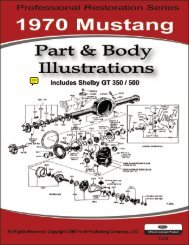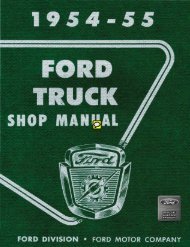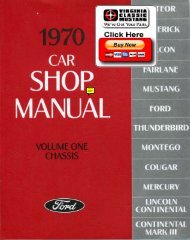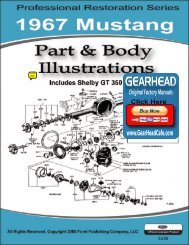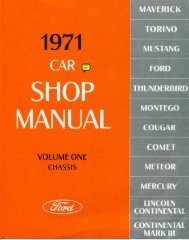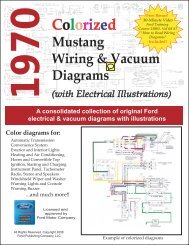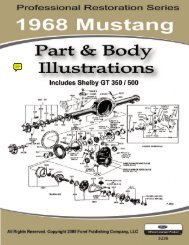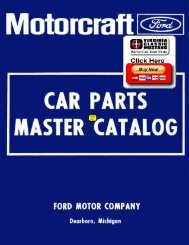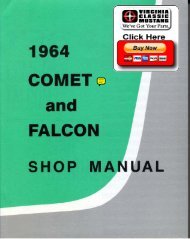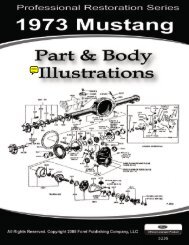DEMO - 1977 Ford Truck Shop Manual - ForelPublishing.com
DEMO - 1977 Ford Truck Shop Manual - ForelPublishing.com
DEMO - 1977 Ford Truck Shop Manual - ForelPublishing.com
You also want an ePaper? Increase the reach of your titles
YUMPU automatically turns print PDFs into web optimized ePapers that Google loves.
11-10-5 Wheels, Hubs and Bearings-Front (Except Front Drive) 11-10-5<br />
REMOVAL AND INSTALLATION<br />
FRONT WHEEL GREASE SEAL<br />
AND BEARING REPLACEMENT<br />
AND REPACKING<br />
Wheel bearing lubricant is a lithium-base<br />
grease, <strong>Ford</strong> specification ESA-MIC75-B<br />
or equivalent.<br />
Sodium-base grease is not <strong>com</strong>patible<br />
with lithium-base grease and should not<br />
be intermixed. Therefore, do not<br />
lubricate front and/or rear wheel<br />
bearings without first ascertaining the<br />
type of original wheel bearing lubricant.<br />
Usage of in<strong>com</strong>patible bearing lubricants<br />
could result in premature lubricant<br />
breakdown. _<br />
If bearing adjustment will not<br />
eliminate looseness or rough and noisy<br />
operation, the hub and bearings should<br />
be cleaned, inspected, and repacked with<br />
specified wheel grease. Ifthe bearing cups<br />
or the cone and roller assemblies are<br />
worn or damaged, they should be<br />
replaced.<br />
DRUM BRAKES<br />
P-600<br />
1. Raise the vehicle until the wheel and<br />
tire clear the floor. Remove wheel and<br />
tire from hub. If drums will not<br />
remove easily, back off the brake shoe<br />
adjusting screw so that the shoes do<br />
not contact the brake drum. Remove<br />
grease cap from the hub.<br />
2. Remove the cotter pin, nut lock,<br />
adjusting nut and washer from the<br />
spindle, Fig. 2.<br />
3. Remove the outer bearing cone and<br />
roller. Pull the hub and drum<br />
assembly off the wheel spindle. Then,<br />
remove and discard the grease<br />
retainer. Remove the inner bearing<br />
cone and roller from the hub. Remove<br />
all traces of old lubricant from<br />
bearings, hubs, and axle spindle.<br />
4. Inspect the cups for scratches, pits or<br />
cracks. If the cups are worn or<br />
damaged, remove them with a drift.<br />
5. Clean the inner and outer bearing<br />
cones and rollers with solvent and dry<br />
thoroughly. Do not spin the bearings<br />
dry with <strong>com</strong>pressed air.<br />
6. Inspect the cones and rollers for<br />
cracks, nicks, brinelling, or seized<br />
rollers. Inspect the grease retainer<br />
and replace it if it is cracked, nicked,<br />
or dented.<br />
7. Cover the spindle with a clean cloth<br />
and brush all loose dust and dirt from<br />
the brake assembly. Remove the cloth<br />
from the spindle carefully to prevent<br />
dirt from falling on the spindle.<br />
8. Install the inner and outer bearing<br />
cups in the hub with T56P-1217-A<br />
installing tool, Fig. 3. Be sure to seat<br />
the cups properly in the hub. The<br />
cups will be properly seated when<br />
they are fully bottomed.<br />
9. Pack the inside of the hub with Multi<br />
Purpose Lubricant <strong>Ford</strong> specification<br />
ESA-MIC75-B or equivalent. Fill the<br />
hub until the grease is flush with the<br />
inside diameters of both bearing cups.<br />
Pack the bearing cones and rollers with<br />
wheel bearing grease. Use a bearing<br />
packer for this operation. If a packer is<br />
not available, work as much lubricant as<br />
possible between the rollers and cages.<br />
Lubricate the cone surfaces with grease.<br />
to. Place the inner bearing cone and<br />
roller in the inner cup and install the<br />
grease retainer (Fig. 4) with the<br />
appropriate driving tool. Be sure that<br />
the retainer is fully bottomed.<br />
11. Install the hub and drum on the wheel<br />
spindle. Keep the hub centered on the<br />
spindle to prevent damage to the<br />
grease retainer or the spindle threads.<br />
12. Install the outer bearing cone and<br />
roller and the flat washer on the<br />
spindle, then install the adjusting nut,<br />
and adjust the wheel bearing as<br />
outlined under Adjustments. Install<br />
the adjusting nut lock, cotter pin and<br />
grease cap.<br />
DISC BRAKES<br />
F-100-F-360, E-100-E-360<br />
1. Raise the vehicle until the tire clears<br />
the floor and remove the wheel and<br />
tire assembly from the hub and rotor.<br />
2. Remove the brake caliper, (refer to<br />
Part 12.24), and wire it to the<br />
underbody to prevent damage to the<br />
brake hose. It is not necessary to<br />
disconnect the hose from the caliper.<br />
Do not let the caliper hang with its<br />
weight on the brake hose or the hose<br />
may be<strong>com</strong>e stretched, twisted or<br />
ruptured.<br />
3. Remove the grease cap, cotter pin,<br />
retainer, nut and washer.<br />
4. Remove the outer bearing cone and<br />
roller.<br />
5. Pull the hub and rotor off the spindle<br />
and remove and discard the grease<br />
retainer.<br />
6. Remove the inner bearing cone and<br />
roller from the hub. Remove all traces<br />
of old lubricant from bearings, hub<br />
and axle spindle.<br />
7. Inspect the cups for scratches, pits or<br />
cracks. If the cups are worn or<br />
damaged, remove them with a drift.<br />
Clean the inner 'and outer bearing<br />
cones and rollers with solvent and dry<br />
thoroughly. Do not spin the bearings<br />
dry with <strong>com</strong>pressed air.<br />
8. Inspect the cones and rollers for<br />
cracks, nicks, brinelling, or seized<br />
rollers. Inspect the grease retainer<br />
and replace it if it is cracked, nicked,<br />
or dented.<br />
9. Cover the spindle with a clean cloth<br />
and brush all loose dust and dirt from<br />
the brake assembly. Remove the cloth<br />
from the spindle carefully to prevent<br />
dirt from falling on the spindle.<br />
10. If inner or outer bearing cups were<br />
removed, install replacement inner<br />
and outer bearing cups in the hub<br />
with tool T56P-1217-A, (Fig. 3). Be<br />
sure to seat the cups properly in the<br />
hub. The cups will be properly seated<br />
when they are fully bottomed.<br />
11. Pack the inside of the hub with<br />
CIAZ-19590-B Multi-Purpose<br />
Lubricant or equivalent. Fill the hub<br />
until the grease is flush with the inside<br />
diameters of both bearing cups. Pack<br />
the bearing cones and rollers with<br />
wheel bearing grease. Use a bearing<br />
packer for this operation. If a packer<br />
is not available, work as much<br />
lubricant as possible between the<br />
rollers and cages. Lubricate the cone<br />
surfaces with grease.<br />
12. Place the inner bearing cone and<br />
roller in the inner cup and install the<br />
new grease retainer with driving tool<br />
T37T-1l90-B, (Fig. 4). Be sure that<br />
the retainer is fully bottomed.<br />
13. Install the hub and rotor on the wheel<br />
spindle. Keep the hub centered on the<br />
spindle to prevent damage to the<br />
grease retainer or the spindle threads.<br />
14. Install the outer bearing cone and<br />
roller and the flat washer on the<br />
spindle, then install the adjusting nut,<br />
and adjust the wheel bearing as<br />
outlined under Adjustments. Install<br />
the grease cap.<br />
15. Install the caliper, (refer to part 12<br />
24).<br />
16. Install the wheel and tire assembly on<br />
the hub.<br />
17. Lower the vehicle and tighten the lug<br />
nuts to specification. Re-install the<br />
wheel cover or hub cap.<br />
MEDIUM, HEAVY AND EXTRA·<br />
HEAVY VEHICLES<br />
There are two basic types ofhubs, disc<br />
and cast, shown in Fig. 1. The basic<br />
design of the hub bearings is the same in<br />
all hubs, but minor differences in size<br />
exist between the various models. The<br />
outer bearing attaching parts differ<br />
according to front axle weight capacity<br />
as indicated in Fig. 1. For further detailed<br />
views of hubs, bearings, and grease<br />
retainers, see Fig. 2.<br />
1. Raise the vehicle until the tires clear<br />
the floor and install safety stands to<br />
support the front axle. Remove the<br />
grease cap and gasket from the hub.<br />
2. To check the wheel bearing<br />
adjustment, alternately push inward<br />
and outward on the tire. If there is




